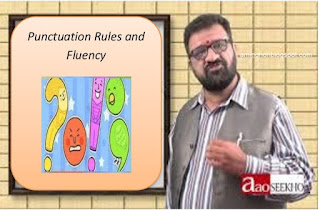Lesson Plan of Punctuation Rules and Fluency English Grade V
Lesson Plan of Punctuation Rules and Fluency
English Grade V
Students’ Learning Outcomes
·
Apply punctuation rules to
assist accuracy and fluency in reading.
Information for Teachers
·
Punctuation marks are symbols that are used to aid the clarity
and comprehension of written language. Some common punctuation marks are the
period, comma, question mark, exclamation point, apostrophe, quotation mark and
hyphen.
·
A capital letter is used at the beginning of a sentence or for
names of people or places.
·
A full stop (.)Is used to show that the sentence has come to
an end. A long pause is given when reading a sentence that finishes with a full
stop.
·
A comma is used to show a pause in the sentences, or
when naming a list of items. Take a short pause or little breath when reading a
sentence with a comma.
·
A question mark? Is used at the end of a sentence when a
question is asked.
·
An exclamation mark is used to show strong feelings.
·
Inverted commas show that the enclosed words were spoken by
someone.
·
Apostrophe ‘It is used to indicate ‘the omission of a sound
or syllable when speaking’.
·
Hyphen: The hyphen (-) is used to join words together,
a short pause between two syllables in speaking
and, more broadly, any small connecting link.
·
Colon: the
colon as a symbol (:) the main functions of the colon is to separate two
clauses, where the second clause explains or follows from the first.
·
The semicolon (;) is used to connect independent clauses. It
shows a closer relationship between the clauses than a period would show.
·
Parentheses: ( ) Parentheses are curved lines used to separate
explanations or qualifying statements within a sentence (each one of the curved
lines is called a parenthesis). The part in the parentheses is called a
parenthetical remark.
·
Dash: —A dash is used to separate parts of a
sentence.
·
The students improve reading
and understanding when stopping (pausing) at full stops, commas.
·
Exclamation marks and
question marks help to read and speak with correct expressions and intonation
patterns.
·
Intonation is the rise and fall in speech. Speech can be
made effective by using variety in speech.
·
Fluency in reading comes with
the practice. If punctuation is right, fluency will start to develop
automatically.
Material / Resources
Chalk/marker, board, textbook, pencils, a chart
of a short passage with dialogues and without punctuation marks taken from the
book
Worm up activity
·
Ask the students what they
know about punctuation marks.
·
Call students one by one to
write the names of punctuation marks on the board and draw their symbols.
·
Ask the function of each
punctuation mark.
Development
Activity 1
·
Before coming to the class
you must a select a short passage with dialogues. Passage must have commas,
full stop, inverted commas, question marks and exclamation marks.
·
Write that passage without
any punctuation marks on the board.
·
Call students individually to
the board and ask them to insert punctuation marks, with colored chalks.
·
Whole class claps for every
correct entry on the chart.
·
Ask another student to do the
correction in case of any mistake.
·
In pairs, students compare
and check the corrected passage with the one in the book.
·
Practice reading the same
passage from their text book following proper punctuation rules, pronunciation
of words and fluency.
Activity 2
·
Choose a dialogue from the
students textbook.
·
Ask the students to work in
groups (depending on the characters in the dialogue) to act out the dialogue in
front of the class.
·
The students can keep their
books with them to read out the dialogues.
Sum up / Conclusion
·
Speak a sentence with a
certain intonation and ask students which punctuation mark will be used in it.
For example, read a question to them.
Assessment
·
Take any short paragraph from
the students’ textbook.
·
Write it on the board without
adding any punctuation marks.
·
Ask the students to copy the
paragraph in their notebooks and add punctuation marks to it.
·
Use the conclusion activity
to assess students’ progress
Follow up
·
Students must practice
reading a passage from their textbook with proper punctuation and fluency in
speech.
·
Give students many
opportunities to read aloud and notice punctuation in texts.
·
Ask students to read the
slides that come on news channels. it would help them learn to read quickly
with intonation and would give them practice of connected speech.




Comments
Post a Comment